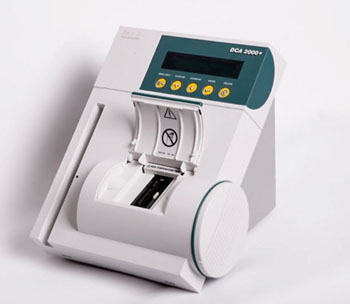Glycated Hemoglobin Testing Simplifies Diabetes Screening In Remote Area
By LabMedica International staff writers
Posted on 22 Jul 2015
In contrast to the current diagnostic blood glucose testing, assessment of glycated hemoglobin A (HbA1c) requires no fasting and this makes it more suitable for opportunistic testing, and results in fewer missed diagnoses.Posted on 22 Jul 2015
Early identification of diabetes and associated complications provides an opportunity to start effective preventive treatment that reduces the subsequent development or progression of macrovascular and microvascular disease.

Image: The Bayer DCA 2000+ Analyzer is a point-of-care diabetes management platform that performs both glycated hemoglobin HbA1c and microalbumin / creatinine tests in minutes (Photo courtesy of Siemens).
Scientists at the Rural Clinical School, University of Western Australia (Broome, Australia) performed a cross-sectional study that independently classified 255 Aboriginal Australians aged 15 years or more without confirmed diabetes and due for diabetes testing at participating clinics. These were six primary health care sites in the Kimberley region of Western Australia from September 1, 2011, to November 30, 2013.
Capillary blood HbA1c concentration was measured in a finger-prick blood sample collected by primary health care providers and analyzed on a point-of-care DCA 2000+ Analyzer (Siemens/Bayer; Erlangen, Germany). Venous plasma HbA1c levels were measured using an automated immunoassay, with anticoagulated whole blood specimens automatically hemolysed by HbA1c hemolysis reagent in the predilution cuvette on a cobas Integra 800 analyzer (Roche Diagnostics; Basel, Switzerland). Venous plasma glucose (PG) levels were measured by enzymatic assay (glucose oxidase spectrophotometric dry chemistry) on a Vitros 250 Analyzer (Ortho Clinical Diagnostics; Rochester, NY, USA).
All participants with a confirmed diagnosis of diabetes were identified by the HbA1c algorithm as having either diabetes including 15 cases or 5 cases of prediabetes. Those classified as having prediabetes are expected to be followed up more frequently, reducing the chance of diabetes in these patients being missed for any length of time. HbA1c testing is clearly more likely to detect diabetes than glucose testing. The investigators found that participants were significantly more likely to receive a definitive test result within seven days using the HbA1c test, and were more likely to be followed up if an initial result was abnormal.
Julia V. Marley, PhD, the lead author said, “Our study shows that adopting the Kimberley HbA1c algorithm may simplify the testing process in previously undiagnosed individuals and provide a timelier and more accurate diagnosis of diabetes for Aboriginal people and other high-risk remote populations in Australia and elsewhere in the world.” The study was published on July 6, 2015, in the Medical Journal of Australia.
Related Links:
University of Western Australia
Siemens/Bayer
Roche Diagnostics













